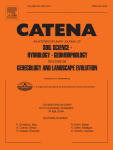Ver ítem
- xmlui.general.dspace_homeCentros Regionales y EEAsCentro Regional Tucumán - Santiago del EsteroEEA Santiago del EsteroArtículos científicosxmlui.ArtifactBrowser.ItemViewer.trail
- Inicio
- Centros Regionales y EEAs
- Centro Regional Tucumán - Santiago del Estero
- EEA Santiago del Estero
- Artículos científicos
- Ver ítem
Accuracy assessment of the geomorphon approach to detect ecological sites in the Dry Chaco region of Argentina
Resumen
Ecological sites are a classification of local-land types based on differences in important environmental factors including soil properties, slope and landscape position within a geomorphologic and climatic zone. The concept is pivotal to conduct adaptative management in arid rangelands because it defines homogeneous areas over which specific soil-vegetation-disturbance dynamic occurs. Geomorphon is a computationally efficient method that uses Digital
[ver mas...]
Ecological sites are a classification of local-land types based on differences in important environmental factors including soil properties, slope and landscape position within a geomorphologic and climatic zone. The concept is pivotal to conduct adaptative management in arid rangelands because it defines homogeneous areas over which specific soil-vegetation-disturbance dynamic occurs. Geomorphon is a computationally efficient method that uses Digital Elevation Models (DEMs) for the classification of landforms at multiple scales. The objective of this study was to evaluate the accuracy of the geomorphon approach to map ecological sites in a 11,259-ha study area within the Dry Chaco region of Argentina, utilizing local topographic positions along soil catena as a
predictor of broader ecological sites classes. We used two DEM pixel resolutions (12.5 m and 30 m) and optimized the flatness threshold (t) and search radius (L) geomorphon parameters. As “ground truth” we used legacy data of 62 soil profiles descriptions. The geomorphon elements detected were reclassified into the three main ecological sites of the study area: highlands, midlands and lowlands. We used the overall disagreement (D) as the main metric for evaluating the accuracy of ecological site classifications. We found that: i) the lowest t value (0.05◦) captured subtle topographical changes and thus more effectively reflected the soil-landscape relationship, and ii) larger L values paired with the lower pixel resolution (30 m) diminished the impact of minor landforms, improving the accuracy of ecological site detections. We determined that the geomorphon model with the pixel resolution of 30 m, t-value of 0.05◦, and L-value of 12 produced the ecological site classification map with the highest accuracy, achieving a moderate-high accuracy (D of 33.9 %). Our study suggests that the geomorphon approach shows potential for consistent, reproducible and easily updatable ecological site mapping over larger areas.
[Cerrar]

Autor
Fuente
Catena 246 : 108409. (November 2024)
Fecha
2024-09-19
Editorial
Elsevier
ISSN
0341-8162
1872-6887
1872-6887
Formato
pdf
Tipo de documento
artículo
Palabras Claves
Derechos de acceso
Restringido
 Excepto donde se diga explicitamente, este item se publica bajo la siguiente descripción: Creative Commons Attribution-NonCommercial-ShareAlike 2.5 Unported (CC BY-NC-SA 2.5)
Excepto donde se diga explicitamente, este item se publica bajo la siguiente descripción: Creative Commons Attribution-NonCommercial-ShareAlike 2.5 Unported (CC BY-NC-SA 2.5)


